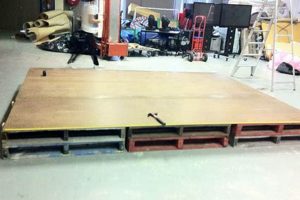The term identifies endeavors centered on constructing items, typically for household or decorative purposes, through the repurposing of wooden pallets. These pallets, initially designed for the transportation of goods, are deconstructed and the resulting lumber is utilized as the primary building material. An example is the creation of a coffee table using reclaimed pallet boards for the tabletop and legs.
Engaging in such activities presents several advantages, including cost-effectiveness due to the readily available and often free source material. Environmentally, it promotes waste reduction by diverting usable wood from landfills. Historically, utilizing reclaimed wood reflects a tradition of resourcefulness, mirroring practices employed in periods of scarcity or during the early stages of industrialization. Furthermore, it can offer opportunities for creative expression and customization tailored to individual needs and preferences.
The following sections will explore specific techniques for pallet deconstruction, suitable finishing methods, project ideas ranging from simple to complex, and safety precautions necessary when working with repurposed lumber.
Essential Considerations for Pallet Wood Construction
The successful execution of projects using repurposed pallets necessitates careful planning and execution. The following tips outline crucial aspects for achieving desired outcomes.
Tip 1: Source Pallets Responsibly: Not all pallets are suitable for reuse. Seek pallets marked with “HT” (heat treated) which indicates they have been treated without harmful chemicals. Avoid pallets marked with “MB” (methyl bromide) as this is a toxic fumigant.
Tip 2: Prioritize Safety During Disassembly: Pallet disassembly can be hazardous. Utilize appropriate safety equipment including eye protection, gloves, and sturdy footwear. Employ tools designed for pallet dismantling to minimize the risk of injury.
Tip 3: Thoroughly Inspect the Wood: Before commencing any project, meticulously inspect each pallet board for nails, staples, splinters, and rot. Remove any embedded metal and discard damaged or weakened wood.
Tip 4: Prepare the Wood Adequately: Sanding the pallet wood is essential to achieve a smooth and safe surface. Employ progressively finer grits of sandpaper to remove imperfections and create a workable substrate for finishing.
Tip 5: Choose Appropriate Finishes: Select wood finishes designed for interior or exterior use depending on the intended application of the project. Consider the impact of the finish on the wood’s appearance and durability. Apply sealant to make the wood projects diy more durable.
Tip 6: Plan for Wood Movement: Pallet wood, like all wood, expands and contracts with changes in humidity. Design projects allowing for this movement to prevent warping or cracking over time.
Tip 7: Use the Right Hardware: Screws are generally preferred over nails for assembling pallet wood projects. Screws provide a stronger and more lasting connection. Choose screw lengths appropriate for the thickness of the wood being joined.
Adhering to these considerations enhances the safety, longevity, and aesthetic appeal of creations made using reclaimed pallet lumber.
The subsequent sections will delve into project-specific guides and best practices for advanced “pallet wood projects diy”.
1. Sourcing
The sourcing stage represents a foundational element in the realm of endeavors involving the repurposing of pallet lumber. The quality, safety, and suitability of the reclaimed material directly influence the success and longevity of any subsequent project.
- Pallet Identification and Marking
Pallets bear markings indicating their treatment method and intended use. Pallets marked “HT” signify heat treatment, a generally acceptable process. Avoid pallets marked “MB,” indicating methyl bromide fumigation, a highly toxic substance. Pallets lacking markings should be treated with caution, as their history remains unknown.
- Source Reliability
Acquiring pallets from reputable sources, such as local businesses or industrial parks, can offer insight into their prior use and storage conditions. Pallets exposed to harsh chemicals or biological contaminants are unsuitable for reuse in projects intended for indoor use or food contact.
- Pallet Condition Assessment
A thorough inspection of potential pallets is crucial. Look for signs of rot, insect infestation, or structural damage. Pallets exhibiting significant decay or compromised integrity should be rejected, as they pose safety risks and yield inferior results.
- Legal and Ethical Considerations
Obtaining permission before taking pallets is imperative. Removing pallets without authorization can constitute theft or trespassing. Respectful and legal acquisition practices ensure sustainable sourcing and avoid potential legal ramifications.
The selection of appropriate pallet sources is not merely a practical consideration but an ethical one. Responsible sourcing practices safeguard health, promote environmental sustainability, and uphold legal standards, ultimately contributing to the viability and integrity of the “pallet wood projects diy” endeavor.
2. Disassembly
Disassembly constitutes a critical phase in any venture involving the repurposing of pallet lumber. This process, involving the separation of the pallet structure into its constituent boards, directly determines the quality and quantity of usable material available for subsequent construction. Improper disassembly techniques can lead to wood damage, rendering portions of the pallet unusable and increasing material waste. Conversely, careful and methodical disassembly yields a greater volume of intact lumber, enhancing the efficiency and cost-effectiveness of the overall project. For example, aggressive prying can result in splitting and splintering, while the strategic use of specialized tools minimizes damage.
Effective pallet disassembly necessitates employing appropriate tools and safety protocols. Tools such as reciprocating saws, specialized pallet dismantling tools, and pry bars facilitate the separation of boards while minimizing the risk of wood breakage. Personal protective equipment, including safety glasses and gloves, is essential to prevent injuries from flying debris and sharp edges. The application of leverage and controlled force, rather than brute strength, is paramount to achieving clean separations without compromising the integrity of the wood. Consideration must also be given to the method of fastening used in the pallet’s construction; different fastener types necessitate different disassembly techniques.
In summation, the disassembly phase is not merely a preparatory step, but an integral component that dictates the success of projects using repurposed pallet lumber. Mastering safe and efficient disassembly techniques maximizes usable material, reduces waste, and ensures the availability of high-quality lumber for the construction phase. Addressing the challenges inherent in this phase streamlines the entire “pallet wood projects diy” process, leading to superior outcomes.
3. Preparation
Preparation, in the context of endeavors using repurposed pallet lumber, directly determines the quality, safety, and longevity of the final product. Deficiencies in preparation will manifest as structural weaknesses, aesthetic imperfections, and potential safety hazards. For instance, failure to adequately remove embedded nails or staples can create a cutting or puncture risk, and neglecting to sand rough surfaces can lead to splinters. The extent of preparation required varies depending on the intended application; projects involving food contact demand more rigorous cleaning and sanding than purely decorative items.
The preparation phase typically encompasses several key processes. These include: thorough cleaning to remove dirt, debris, and biological contaminants; meticulous inspection for damage, rot, or insect infestation; the removal of all fasteners such as nails, screws, and staples; and sanding to achieve a smooth, uniform surface. Specific projects may also necessitate specialized preparation techniques such as wood filling to repair imperfections or the application of wood preservatives to enhance durability. Consider a project to construct outdoor furniture: meticulous preparation would involve selecting weather-resistant wood preservatives and applying several coats of protective sealant to withstand exposure to the elements.
In summation, preparation is not merely a preliminary step but an integral component directly influencing the success and outcome of “pallet wood projects diy”. Investing adequate time and effort in thorough preparation maximizes the usable material yield, mitigates safety risks, and ensures the creation of high-quality, aesthetically pleasing items. Neglecting preparation will compromise the integrity and long-term viability of any pallet wood construction.
4. Construction
In the context of endeavors centered on repurposing pallet lumber, “construction” represents the pivotal stage where disassembled and prepared materials are assembled into a desired form. It is the direct application of design and planning, translating conceptual ideas into tangible objects. The quality of the construction phase significantly influences the structural integrity, aesthetic appeal, and overall functionality of finished items. An example is the assembly of a pallet wood bed frame: precise joinery and secure fastening are critical to ensuring stability and preventing collapse under weight.
The “construction” phase encompasses a wide range of techniques, including cutting, shaping, joining, and fastening. The selection of appropriate construction methods depends on the project’s complexity, intended use, and aesthetic requirements. For instance, simple projects such as pallet wood signs may require only basic cutting and fastening, while more complex projects like pallet wood furniture necessitate advanced joinery techniques, such as mortise and tenon or dovetail joints, to achieve robust and durable structures. Moreover, the selection of appropriate fasteners, such as screws, nails, or bolts, plays a crucial role in ensuring structural stability. The assembly of a garden planter from pallet wood requires consideration of drainage and soil retention, demanding thoughtful construction techniques to prevent water damage and maintain structural integrity.
Construction is not merely a mechanical process; it demands a synthesis of technical skill, design awareness, and an understanding of material properties. Mastery of construction techniques is essential for realizing the full potential of projects using repurposed pallet lumber. Addressing the challenges inherent in this phase streamlines the entire “pallet wood projects diy” process, leading to superior outcomes. In essence, successful construction is the bridge between raw materials and a finished, functional item, underscoring its importance in the overall endeavor.
5. Finishing
Finishing, in the context of projects utilizing reclaimed pallet lumber, represents a crucial stage that directly impacts the durability, aesthetics, and safety of the completed item. This process extends beyond mere cosmetic enhancement, serving as a protective barrier against environmental factors and physical wear. Selection and application of appropriate finishing techniques are essential to maximize the lifespan and utility of items constructed from repurposed materials.
- Protection Against Environmental Factors
Pallet lumber, often exposed to the elements during its initial use, can be susceptible to moisture damage, insect infestation, and UV degradation. Finishes such as sealants, varnishes, and exterior paints provide a protective layer that shields the wood from these detrimental effects. For example, a pallet wood garden bench requires a water-resistant finish to prevent rot and decay from prolonged exposure to rain and humidity.
- Enhancement of Aesthetic Appeal
Finishing techniques allow for customization of the wood’s appearance, bringing out its natural grain patterns, adding color, or creating a specific texture. Stains, paints, and waxes can transform the look of pallet lumber from rustic to refined, complementing the style of the project. The application of a clear coat varnish to a pallet wood coffee table can highlight the natural wood grain while providing a smooth, durable surface.
- Improvement of Surface Safety and Hygiene
Pallet lumber often possesses a rough texture and may contain splinters or sharp edges. Sanding and the application of a smooth finish, such as polyurethane, create a safer surface for handling and use. For items intended for food contact, such as cutting boards or serving trays, food-safe finishes are essential to prevent contamination and ensure hygiene.
- Preservation of Wood Integrity
Certain finishes, such as wood preservatives, contain chemicals that inhibit the growth of mold, mildew, and wood-boring insects. These treatments extend the life of pallet lumber, particularly when used in outdoor applications. Applying a wood preservative to a pallet wood fence can prevent decay and prolong its lifespan by several years.
These facets highlight the integral relationship between the terminal processing and projects constructed from repurposed pallet lumber. By thoughtfully selecting and applying suitable treatments, the longevity, visual character, and security of pallet wood creations are significantly enhanced, therefore the act of adding a finish is often an integral element to any project using reclaimed pallet lumber.
Frequently Asked Questions
The following addresses common inquiries and clarifies misconceptions regarding the creation of projects utilizing repurposed pallet lumber. These questions are designed to provide information and guidance to individuals engaging in such endeavors.
Question 1: How does one identify pallets suitable for reuse in projects?
Pallets suitable for reuse are typically marked with “HT,” indicating heat treatment. Avoid pallets marked with “MB,” signifying methyl bromide fumigation, a toxic process. Pallets lacking markings should be treated with caution.
Question 2: What safety precautions are necessary during pallet disassembly?
Eye protection, gloves, and sturdy footwear are essential safety equipment. Employ tools designed for pallet dismantling to minimize the risk of injury. Exercise caution when removing fasteners, as they may be sharp or damaged.
Question 3: How is pallet wood prepared for use in projects?
Pallet wood preparation involves thorough cleaning, inspection for damage, removal of fasteners, and sanding to achieve a smooth surface. Specialized preparation techniques, such as wood filling or preservative application, may be necessary depending on the project.
Question 4: What are the critical considerations for constructing pallet wood projects?
Careful selection of joinery techniques and fasteners is crucial for structural integrity. Account for wood movement due to changes in humidity. Ensure proper drainage for outdoor projects to prevent rot and decay.
Question 5: What types of finishes are suitable for pallet wood projects?
The selection of finish depends on the intended use. Sealants, varnishes, and exterior paints offer protection against environmental factors. Food-safe finishes are required for items intended for food contact. Wood preservatives can extend the life of pallet lumber in outdoor applications.
Question 6: What are the potential risks associated with pallet wood and how can they be mitigated?
Potential risks include exposure to chemicals, splinters, and structural instability. These risks can be mitigated by careful pallet selection, proper preparation, and sound construction techniques. Adherence to safety guidelines is imperative.
Thorough understanding of these considerations enhances the likelihood of success and mitigates potential risks associated with projects utilizing repurposed pallet lumber.
The concluding section will summarize the key points discussed and provide recommendations for further exploration.
Conclusion
This article has explored “pallet wood projects diy”, emphasizing the critical steps involved, from responsible sourcing and safe disassembly to thorough preparation, sound construction, and appropriate finishing. The importance of understanding material properties and adhering to safety guidelines has been underscored throughout. Successful execution of these projects requires a combination of technical skill, practical knowledge, and a commitment to ethical sourcing.
The information provided herein serves as a foundation for engaging in creative endeavors utilizing reclaimed pallet lumber. Continued research and refinement of techniques are encouraged to maximize the potential of this resourceful and environmentally conscious approach to construction. The careful application of these principles will yield durable, aesthetically pleasing, and structurally sound items.



![[DIY Guide] Easy DIY Wood Window Shutters You Can Build! The DIY Hub: Creative Crafts, Repairs & Life Hacks [DIY Guide] Easy DIY Wood Window Shutters You Can Build! | The DIY Hub: Creative Crafts, Repairs & Life Hacks](https://craftingdiycenter.com/wp-content/uploads/2025/07/th-3579-300x200.jpg)



